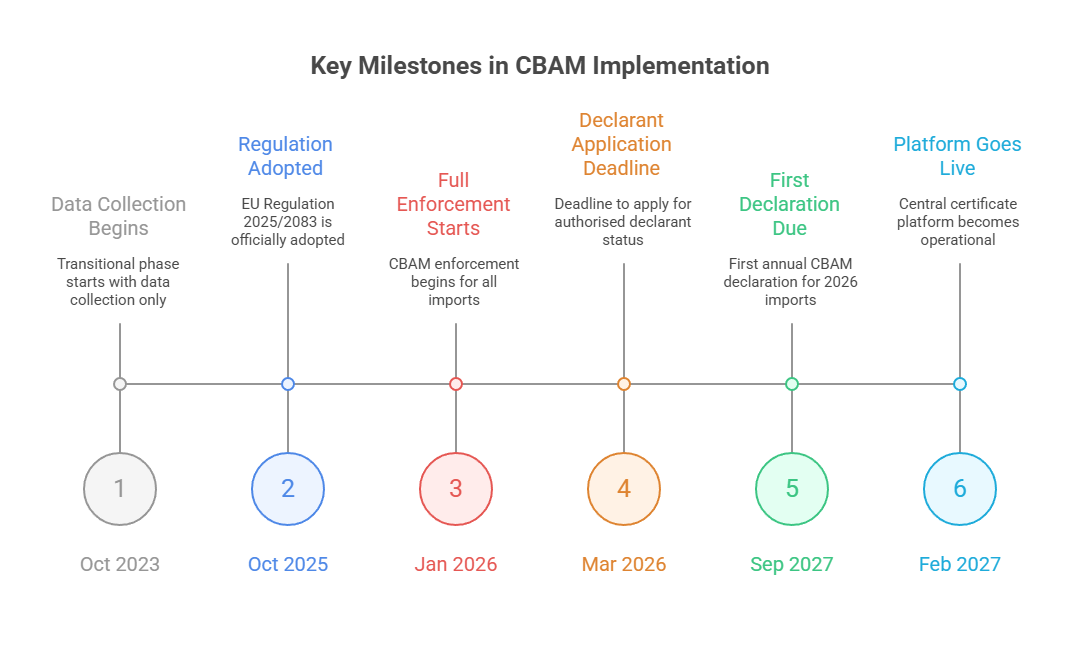Table of Contents
The Transition Is Over CBAM Gets Operational
For two years, CBAM lived in a testing sandbox. Companies submitted quarterly emission reports, customs offices experimented with data collection, and the European Commission quietly gathered evidence on what worked and what didn’t.
On 8 October 2025, the EU adopted Regulation (EU) 2025/2083, officially rewriting key parts of the original CBAM Regulation 2023/956. The message is clear: CBAM isn’t easing up it’s being made enforceable.
Why the Amendment Was Needed
The Commission’s analysis of the transitional period exposed a simple reality: a handful of importers account for almost all embedded emissions, while thousands of small importers were drowning in reporting overhead for negligible impact.
The 2025 amendment tackles that imbalance head-on lightening administrative load for small operators, tightening control where emissions actually come from.
What’s Changed in CBAM 2025/2083
- 50-Tonne De Minimis Threshold
Importers whose total annual CBAM-covered imports (iron & steel, aluminium, fertilisers, cement) do not exceed 50 tonnes are now exempt from CBAM reporting and certificate obligations. Cross that line once, and the full year’s imports fall under CBAM. Electricity and hydrogen remain fully covered; no exemptions apply.
- Authorised CBAM Declarant Clarity
Indirect customs representatives must obtain authorisation before filing on behalf of importers. They carry the same liability and penalties as importers, ending the grey zone in customs representation.
- Simplified Reporting and Later Deadlines
Annual CBAM declarations move to 30 September each year (first full filing in 2027 for 2026 imports). Only actual emissions require third-party verification; default values are Commission-issued.
- Carbon Price Recognition
Importers can deduct verified carbon prices paid in third countries. The Commission will publish annual default carbon price values per country (in €/t CO₂e), reducing guesswork and manual audit burden.
- Central CBAM Certificate Platform (2027)
From February 2027, Member States will sell CBAM certificates via a single EU platform. The fee model will eventually self-finance the system, ensuring transparent pricing aligned with EU ETS allowance averages.
- Tighter Penalty Structure
Penalties now mirror EU ETS rules, up to €100 per missing tonne CO₂e, indexed annually. Authorities can reduce penalties for minor errors or third-party verification faults but will apply full sanctions for non-genuine threshold splitting or unauthorised imports.
What It Means for Importers and Manufacturers
CBAM 2025/2083 is a reset of operational expectations, not a policy shift.
- Small importers finally get breathing room under the 50-tonne exemption.
- Large importers now face a zero-tolerance data environment, real verification, cross-border data matching, and automatic threshold monitoring through customs systems.
- Indirect representatives move from paper filers to accountable actors.
- Penalties and audit frequency align directly with EU ETS, closing the last gap between carbon pricing and import responsibility.
The Commission will review the threshold annually to ensure that 99 % of embedded emissions remain within CBAM scope, meaning coverage is intact even as complexity drops.
How Acquis Makes CBAM Practical
For most companies, the challenge is no longer “what to report,” but how to keep it auditable, linked to suppliers, and verifiable.
Acquis CBAM Automation Suite eliminates the manual choke-points:
- Mass-based threshold tracking real-time monitoring across suppliers and CN codes.
- Automated emission data validation via supplier CoC and ECHA-aligned defaults.
- Carbon-price deduction logic with built-in country price tables.
- Certificate management dashboard synced to EU ETS averages.
- Declarant status registry integration for customs and authorisation tracking.
Acquis turns Regulation (EU) 2025/2083 from a compliance liability into a data advantage, centralising reporting, reducing manual error risk, and future-proofing for 2026 audits.
Key Timeline for CBAM

Prepare your 2026 CBAM file now — automate threshold tracking and certificate management with Acquis. Request a CBAM demo →
